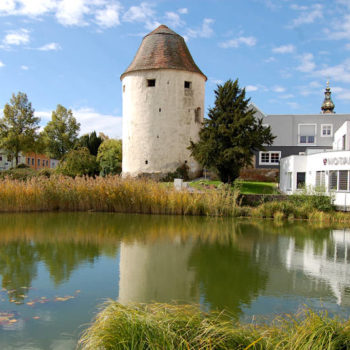Hartberg in eastern Styria is one of Austria’s cosiest small historic towns. Here you can relax in one of the cafes on the square or stroll around and admire the historic streets.
Many old buildings are well preserved, creating a great atmosphere. The historic centre of Hartberg lies within the partially preserved city wall from the Middle Ages (12th and 13th centuries), which once surrounded the entire town. Today, visitors and residents enjoy a place where you can relax and enjoy life – in historic surroundings.
The slow city
Hartberg was the second city in Austria to receive the internationally recognized “Città Slow” certification. This special award stands for the joy of life in the slow lane. We took this literally and had a cup of coffee in the Hauptplatz (city square) before strolling slowly away. Many parking spaces had to give way to outdoor seating, playgrounds and art. Moreover, the historic centre of Hartberg is relatively tiny. Hence you don’t need to plan too much, but get an overview on Google Maps before you start sightseeing. Already around the square itself, there is much to see.
< Click to see the images larger >
Historic buildings
The first building most people notice is the Stadtpfarrkirche St. Martin (parish church), which dominates the city’s skyline and not least the main square, with its 54-meter-high church tower. The first church building was erected in 1128 and stood on top of the remains of a Roman villa from around 200 AD. Perhaps just as interesting is what you find behind the church. Here stands a round tower that sticks out. The so-called Hartberger Karner (ossuary) was built in the second half of the 12th century and was extensively renovated between 1889 and 1894.
Moreover, the renovations revealed the frescoes inside (from around 1200), which you should see. No worries, the bones of the dead are long gone. Another eye-catching building is the yellow house just across the main square in Kirchengasse 2, which today still houses a pharmacy, which is also impressive. Furthermore, the core of the former pharmacist’s house, J. D. Rahmann, dates from 1668. It received its elaborate neo-baroque facade at the end of the 19th century.
ADVERTISEMENT
Walking down the pedestrian street from the square, you soon notice a so-called Bürgerhaus in Wiener Strasse 7. The house has just been refurbished and appears in all its glory. The white facade with details in red and gold testifies that there were wealthy people who lived here once upon a time. We could have continued the list of noteworthy, historic buildings, but we leave the rest for you to discover, so we have space to mention other sights.
Schloss Hartberg (Palace)
In the northwest corner of the old town, you will find Schloss Hartberg. The castle’s history goes back to the year 1147 when the castle was first mentioned in written records. The castle was bought in 1572 by the family of the later Princes Paar and rebuilt in Renaissance style. In the 17th century, it was extended to include an arcade wing. The castle today belongs to the city and is used for cultural events. You can freely stroll around the castle park and perhaps enjoy some goodies you bought at the farmers’ market.
Bauernmarkt (Farmers’ market)
At Europaplatz (Grazer Strasse), you will find a small market along the pavement. Here you can shop for a small picnic basket with, for example, cheese, bread, local apple or grape juice and fruit. In addition, there are also delicious, handmade sweet pastries for sale. In addition, you will also find a couple of other parks where you can enjoy your treats.
Rochuspark
In the southeast corner of Hartberg, the Schölbingerturm stands out. The white medieval tower stands next to a small but lovely park (Rochuspark), including a pond with a fountain. There is also a small playground here. It is 4-500 meters / 5 minutes on foot through the pedestrian street from the main square or via Michaeligasse and Europaplatz. Finally, you will find the Stadtpark (City park) just around the corner from the market, with quiet places to relax. Here you can also see a preserved section of the city wall and return to the centre through the gate at the Reckturm. So wherever you stroll, you always have a historical backdrop.
Sights outside Hartberg
The town’s settlement history is well over 2,000 years long and has left numerous archaeological traces, which tell exciting stories. Hartberg is an ancient settlement area, and settlements can be traced back to the Celts and later to Roman times. Henceforth, only about 3 km outside the centre of Hartberg you find the remains of “Villa Rustika”. These well-preserved foundations of a large Roman country estate from the 2nd and 3rd centuries AD gives you an idea of the luxury of that era. In the palatial peristyle villa, you will find among others, the remains of a Roman bath, a large representation hall and extensive living quarters.


















